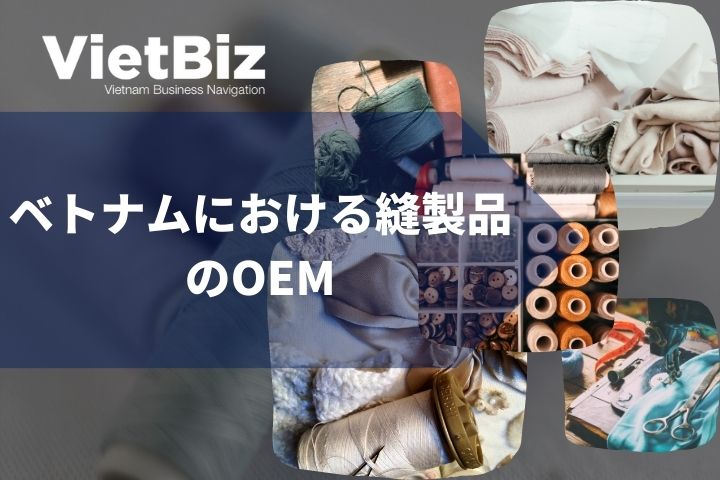Introduction
Vietnam has long been a manufacturing base for the sewing industry, with many foreign apparel companies entering the country. With the recent economic development, Vietnam has been attracting attention not as a manufacturing base but as a consumer market. On the other hand, labor costs in the manufacturing industry have not yet risen fully, and Vietnam continues to be considered a promising manufacturing base.
This report describes the OEM market for sewn products in Vietnam. We will discuss the current situation, advantages over other countries, quality control, and benefits for Japanese companies from various perspectives.
The Current Vietnamese OEM Market for Sewing Products

Many Japanese companies have been operating in Vietnam for some time, and an increasing number continue to do so. OEM of sewn products in Vietnam has been very active for a long time and is a large market for Japanese companies.
The main products in Vietnam’s OEM market for sewn products are garments, bags, shoes, and bedding. In addition, there is a growing interest in the production of products that require functionality, such as sportswear and outdoor wear.
The OEM market for sewn products in Vietnam is a mix of large manufacturers and small and medium-sized companies. Large manufacturers have well-developed production lines and high production efficiency, making them suitable for mass production. On the other hand, small and medium-sized companies have the flexibility to respond to detailed orders and focus on quality control, making them suitable for high-mix low-volume production.
The low cost of labor is a major advantage in Vietnam’s OEM market for sewn products. In addition, the government is focusing on the country as a production base for sewn products, and investment in the manufacturing industry has been aggressive. In addition, international trade agreements have facilitated exports.
However, there are some challenges in the Vietnamese OEM market for sewn products. First, there is the issue of quality control. While some companies put a lot of effort into quality control, some companies cut corners easily. There are also problems related to delivery, which often results in late deliveries.
Vietnam’s Advantages as A Production Base
This chapter explains Vietnam’s advantages as a production base.

Low Labor Costs
One of the major advantages of Vietnam is its inexpensive labor costs. Minimum wages are also relatively low, which generally eliminates the labor cost problems faced by Japanese companies. In addition, the country has an abundant working population, making it easy to secure human resources.
Geographical Conditions
Vietnam is located in the center of Southeast Asia and is an excellent base for ocean and land transportation, facilitating exports to the rest of the world. In addition, its border with China makes it particularly well suited for products destined for China.
Government Support
The Vietnamese government is focusing on the development of the manufacturing industry and implementing aggressive policies such as attracting foreign companies. In addition, preferential treatment in terms of taxation and labor laws for foreign investment has created an attractive environment for foreign companies.
Maintenance of Production Lines
Vietnam has experienced rapid economic development in recent years, and in the manufacturing industry, production lines are being developed. For major manufacturers, production lines are being equipped with more modern equipment, allowing for more efficient production and further meeting the demands of companies from developed countries.
Quality Control in Vietnam

This chapter describes quality control and assurance in sewing in Vietnam.
ISO Certification
In Vietnam, an increasing number of companies are acquiring ISO certification, an international certification for quality management. Especially in the manufacturing industry, it is common for companies to obtain ISO 9001 and ISO 14001 certifications. This clarifies the quality control process under international standards and makes it more reliable.
Seven QC Tools
Vietnam has adopted the Seven QC Tools as the basis for quality control. These are seven tools for quality improvement using statistical methods, which help to identify, analyze, and improve quality.
Establishment of Inspection System
In the Vietnamese manufacturing industry, an inspection system for quality control is in place. Quality is assured through inspections at each stage of the production line and final inspections. In addition, OEMs from European and U.S. companies are inspected to ensure strict adherence to quality standards.
Reliability of Quality Control in Vietnam
Quality control in Vietnam is highly reliable in terms of.
Improvement of educational standards
In Vietnam, the level of education is improving and experts in quality control are being trained. In addition, quality control techniques are being incorporated through technology transfer and influx of human resources from abroad.
Growing Consumer Awareness
In Vietnam, the importance of quality control is increasingly recognized due to growing consumer awareness. Companies are also increasingly focusing on quality control, as they are required to respond to consumer complaints.
Advantages of OEM Production of Sewn Products in Vietnam for Japanese Companies

This chapter will list the advantages for Japanese companies to OEM sewn products in Vietnam.
Low Cost
Vietnam’s relatively low labor costs enable low-cost production in the manufacturing industry. In addition, the government offers preferential tax treatment to foreign companies, which can be expected to reduce production costs for foreign companies.
High Production Technology
Many foreign companies, including Japanese firms, have established operations in Vietnam, and the level of production technology is improving. In addition, Vietnam has long been a country with a thriving textile industry, so the original level of production technology is also high.
Excellent and Abundant Workforce
Vietnam has a population of approximately 100 million and a young average age. It has an abundant labor force and high production capacity. Particularly in the textile industry, the number of production lines can be increased quickly, which is another reason why Vietnam is suited for mass production.
Manufacture of High Quality Products
In Vietnam, an increasing number of companies have obtained ISO certification, an international certification for quality control. In addition, in OEMs from Western companies, inspections are conducted to ensure strict adherence to quality standards. This enables the production of high-quality products.
Manufacture of A Wide Variety of Products
Vietnam is capable of manufacturing not only sewing products but also a diverse range of other products such as electronics, auto parts, and food products.
OEMs outside of the sewing industry can also engage in OEMs, allowing Japanese companies more flexibility in their business development.
Future Prospects for Vietnam’s OEM Market for Sewing Products

This chapter describes the future prospects for Vietnam’s OEM market for sewn products.
Increased Demand
In recent years, demand for clothing has been increasing around the world, especially in Asia. Among these, many brands have entered the Asian market, where purchasing power is growing stronger, and demand for clothing in Asia is rising. In addition, among Asian countries, Vietnam is expected to grow further because of its ability to manufacture high-quality products at low cost.
Increase in The Number of Foreign Companies Entering The Market
In recent years, an increasing number of foreign companies have entered the Vietnamese market. Among them, the textile industry is attracting attention, especially from Japanese firms, and Vietnam’s textile industry continues to grow. With the entry of foreign firms, Vietnam’s OEM market for sewn products is also expected to expand.
Expansion of government support measures
The Vietnamese government is making efforts to improve the investment environment by offering preferential tax treatment to foreign companies. There is also a movement to require companies to fulfill their social responsibilities, such as environmental protection and compliance with labor laws. As a result, more stable development is expected for the OEM market for sewn products in Vietnam.
Increased Productivity due to Technological Advances
In the Vietnamese OEM market for sewn products, there is a need to improve productivity. To this end, advances in technological standards, such as the introduction of automation and IoT, are underway. This is expected to enable more efficient production and market expansion.
Summary
This report provides a comprehensive overview of the sewn products OEM market in Vietnam. While maintaining relatively low labor costs, Vietnam is expanding investment in production lines and acquisition of quality certification, enabling the manufacture of inexpensive, high-quality products.
Vietnam’s economy has historically developed as a manufacturing center, with a focus on machinery and sewn products. Although national income has increased and the country is now attracting attention as a consumer market, manufacturing is still a core industry in Vietnam.
We need to continue to closely monitor how Vietnam’s manufacturing sector will grow in the future amid the danger of increasing country risk in China.
▼ベトナムの縫製品OEMについてご検討の方は、以下からご連絡ください。
【関連記事】ベトナムについては、こちらの記事も合わせてご覧ください。









